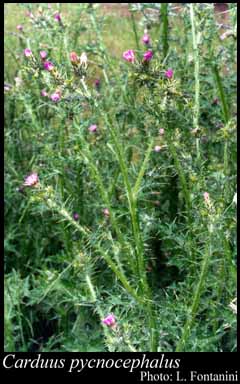- Reference
- Sp.Pl. [Linnaeus] Ed.2,2:1151 (1763)
- Conservation Code
- Not threatened
- Naturalised Status
- Alien to Western Australia
- Name Status
- Current
Erect, prickly annual, herb, 0.2-1 m high. Fl. purple-pink-red, Oct to Dec. Weed of roadsides & pastures.

Distribution
- IBRA Regions
- Avon Wheatbelt, Coolgardie, Esperance Plains, Jarrah Forest, Mallee, Swan Coastal Plain, Warren.
- IBRA Subregions
- Fitzgerald, Katanning, Mardabilla, Northern Jarrah Forest, Perth, Recherche, Southern Jarrah Forest, Warren, Western Mallee.
- IMCRA Regions
- Leeuwin-Naturaliste, WA South Coast.
- Local Government Areas (LGAs)
- Albany, Armadale, Boyup Brook, Bridgetown-Greenbushes, Busselton, Cambridge, Capel, Chittering, Denmark, Dumbleyung, Esperance, Gingin, Harvey, Jerramungup, Kondinin, Manjimup, Murray, Nannup, Nedlands, Northam, Plantagenet, Rockingham, Serpentine-Jarrahdale, Toodyay, Wanneroo, Waroona, York.
Management Notes (for the Swan NRM Region)
Alternative Names. Italian Thistle, Plymouth Thistle, Shore Thistle.
General Biology. Growth form. Herb. Life form. Annual. Reproduction. Seed. Dispersal. Wind, water, birds. Toxicity. Potentially toxic to stock due to nitrates. Seedbank persistence. 10+ years.
Notes. Can form a dense cover that reduces establishment and diplaces other plants. Prefers fertile soils. Germination generally occurs 4-6 weeks following autumn rains and is not staggered. Seed germinates rapidly, generally on open bare ground, and at high rates at a range of alternating temperatures. Produces two types of seed in each flower head. Those in the centre are not dormant and are easily dispersed by wind due to a large pappus, while the outer seed can be dormant and have no obvious means of dispersal. A biological control program tested two agents, a weevil and rust fungus. Hybridisation with Carduus tenuiflorus is common. Declared plant in Victoria, South Australia and Tasmania.
Additional information. Origin. Macaronesia, temperate Asia, tropical Asia, Europe. Similar exotic species. Carduus tenuiflorus.
Suggested method of management and control. Hand remove isolated plants through spring and early summer. Glyphosate at 50% applied by wick or spot spraying with 0.5% glyphosate provides good control. Alternatively spot spray Lontrel® 10 ml/10 L + wetting agent. Best controlled at rosette stage. An integrated program involving a combination of techniques will be most effective. Read the manufacturers' labels and material safety data sheets before using herbicides. For further information consult the Australian Pesticides and Veterinary Medicines Authority to determine the status of permits for your situation or state.
Management Calendar
| Calendar Type | Jan | Feb | Mar | Apr | May | Jun | Jul | Aug | Sep | Oct | Nov | Dec | Comments |
|---|---|---|---|---|---|---|---|---|---|---|---|---|---|
| Germination | O | Y | Y | ||||||||||
| Active Growth | Y | Y | Y | Y | Y | Y | |||||||
| Flowering | Y | Y | Y | ||||||||||
| Fruiting | Y | Y | |||||||||||
| Manual Removal | Y | Y | Y | Y | Y | ||||||||
| Herbicide Treatment | Y | Y | Y | Y | Y |
Legend: Y = Yes, regularly, O = Occasionally, U = Uncertain, referred by others but not confirmed.
References
- Brown, K. & Brooks, K. (2002) Bushland Weeds: A Practical Guide to their Management. Environmental Weeds Action Network, Greenwood.
- Evans, R.A., Young, J.A. & Hawkes, R. (1979) Germination characteristics of Italian Thistle (Carduus pycnocephalus) and Slenderflower Thistle (C. tenuiflorus). Weed Science, 27 (3).
- Forcella, F. & Wood, H. (1986) Sequential flowering of thistles (Cynareae, Asteraceae) in southern Australia. Australian Journal of Botany, 34: 455-61.
- Groves, R.H. & Kaye, P.E. (1989) Germination and phenology of seven introduced thistle species in southern Australia. Australian Journal of Botany, 37 (4): 351-359.
- Harradine, A.R. (1985) Dispersal and establishment of slender thistle, Carduus pycnocephalus L. as affected by ground cover. Australian Journal of Agricultural Research, 36 (6): 791 - 797.
- Hussey, B.M.J., Keighery, G.J., Dodd, J., Lloyd, S.G. & Cousens, R.D. (2007) Western Weeds. A guide to the weeds of Western Australia. 2nd Edition. The Plant Protection Society of Western Australia, Victoria Park.
- Moore, C.B. & Moore, J.H. (2002) Herbiguide, the pesticide expert on a disk. Herbiguide, PO Box 44 Albany, Western Australia, 6330.
- Olivieri, I. (1985) Comparitive electrophoretic studies of Carduus pycnocephalus L., C. tenuiflorus Curt. (Asteraceae), and their hybrids. American Journal of Botany, 72 (5): 715-718.
- Olivieri, I., Swan, M. & Gouyon, P. (1983) Reproductive system and colonizing strategy of two species of Carduus (Compositae). Oecologia, 60 (1): 114-117.
- Parsons, W.T. & Cuthbertson, E.G. (2001) Noxious weeds of Australia. 2nd Edition. CSIRO Publishing, Collingwood.
- Pitcher, D. (revised by Rosso, M.J.) (2004) Element steward abstract for Carduus pycnocephalus, Italian Thistle. The Nature Conservancy, Arlington, Virginia.
- Sindel, B.M. (1991) A review of the ecology and control of thistles in Australia. Weed Research, 31: 189-201.
- USDA, ARS, National Genetic Resources Program (2009) Germplasm Resources Information Network - (GRIN). National Germplasm Resources Laboratory, Beltsville, Maryland. URL: https://npgsweb.ars-grin.gov/gringlobal/taxon/taxonomysimple.aspx - Accessed October 2009.
- Wenziker, K.J., Calvera, M.C. & Woodburn, T.L. (2003) Laboratory trials of the efficacy of the Crown Weevil Mortadelo horridus (Coleoptera: Curculionoidae) for the biological control of Slender Thistles Carduus pycnocephalus and C. tenuiflorus in southwestern Australia. Biocontrol Science and Technology, 13 (7): 655 - 670.